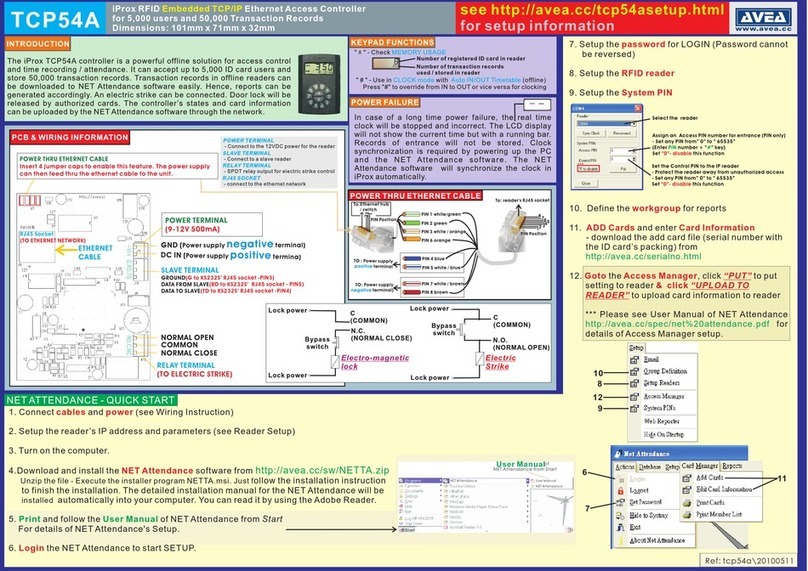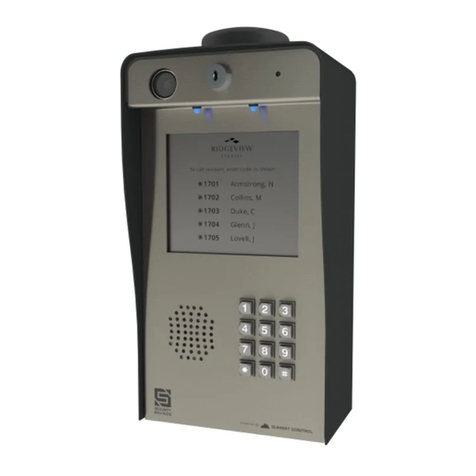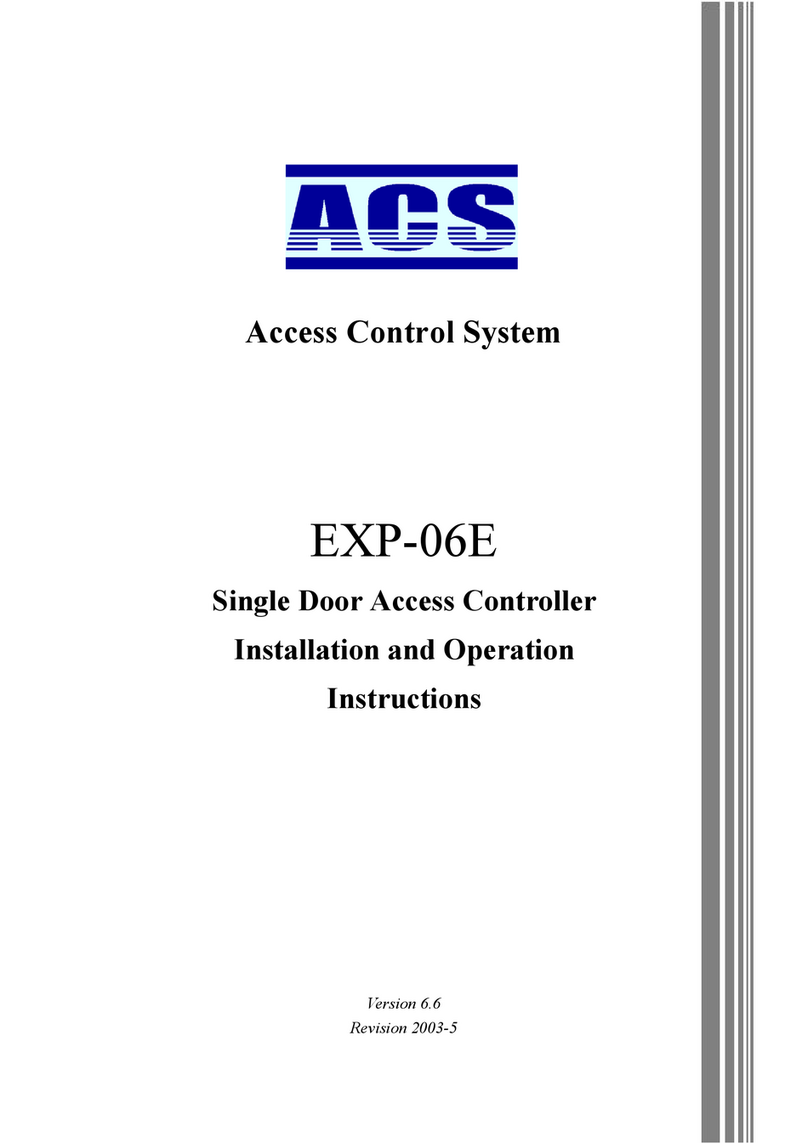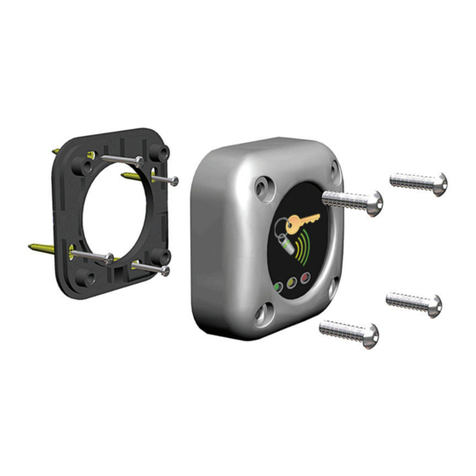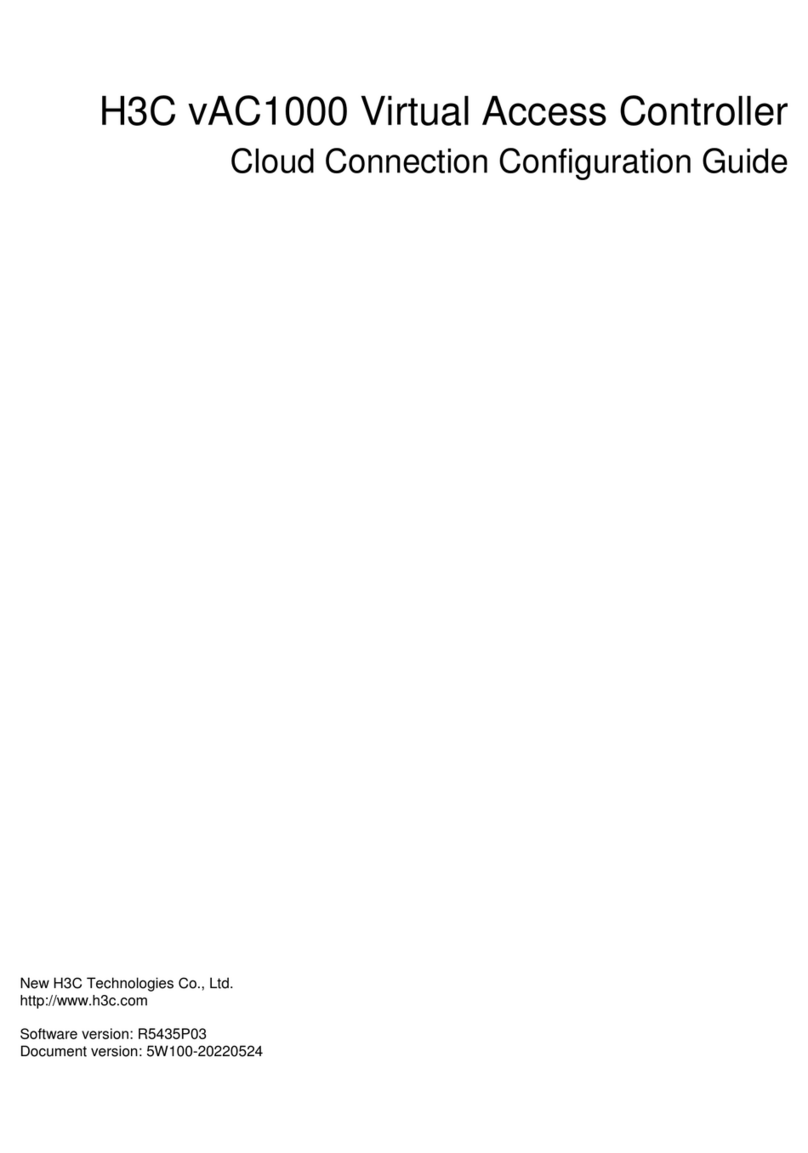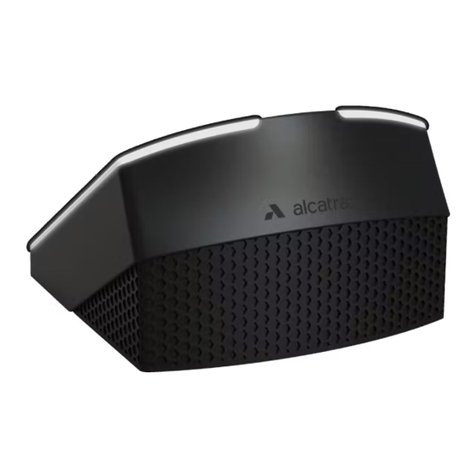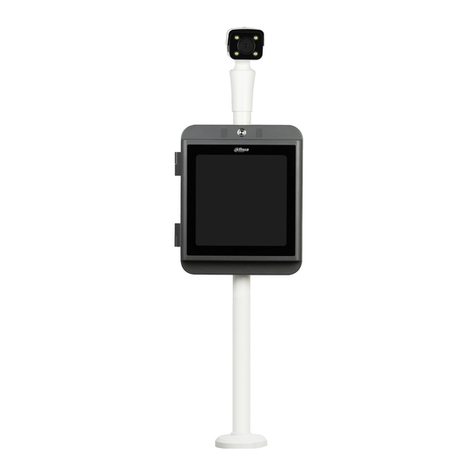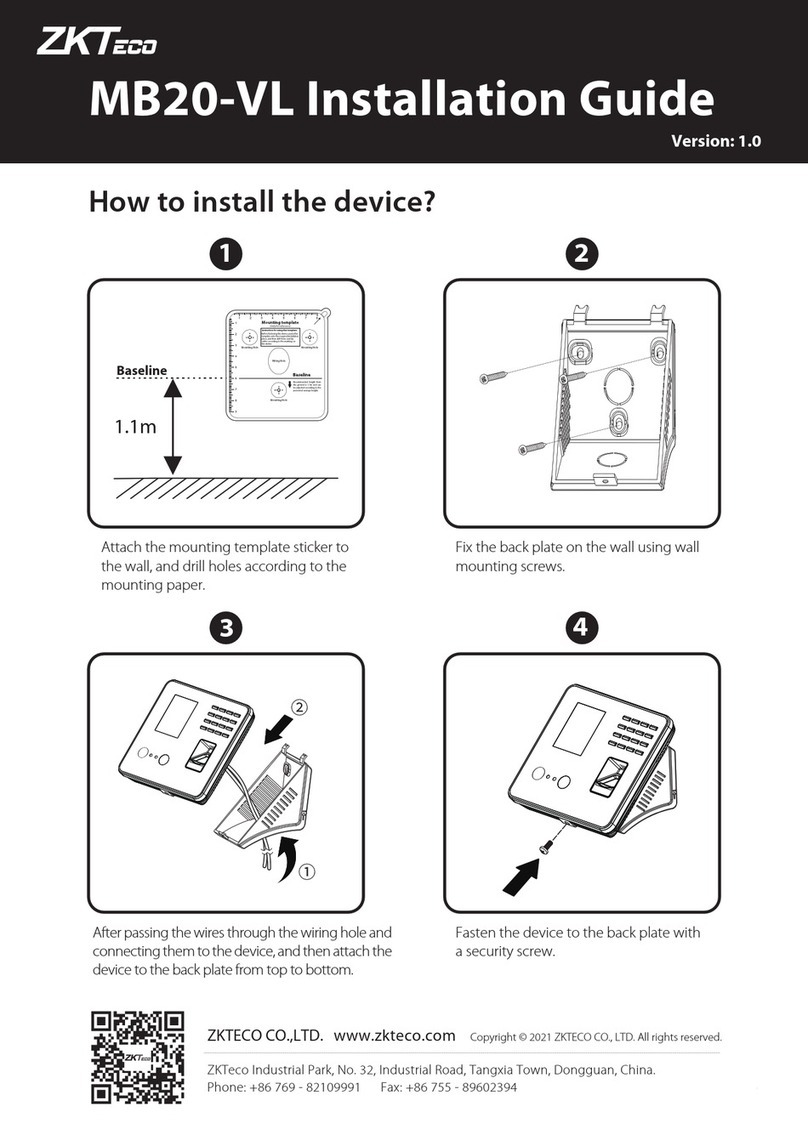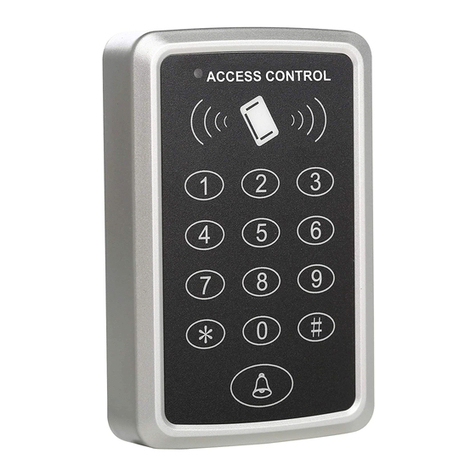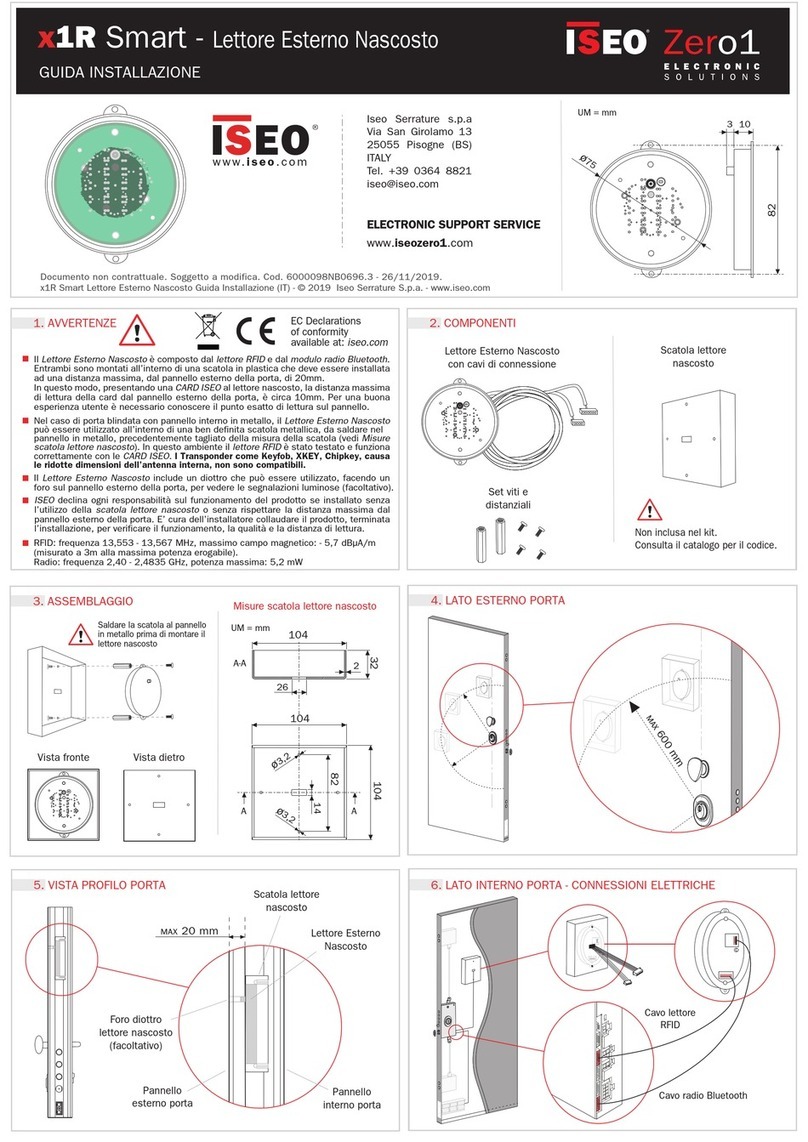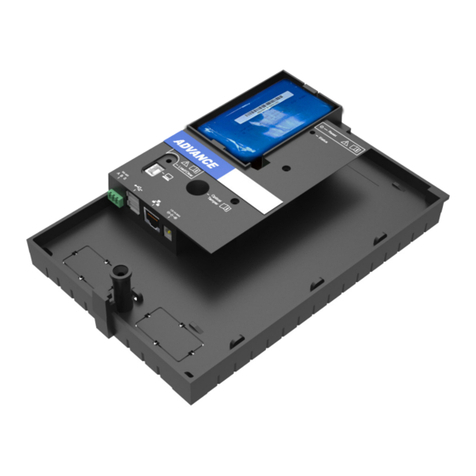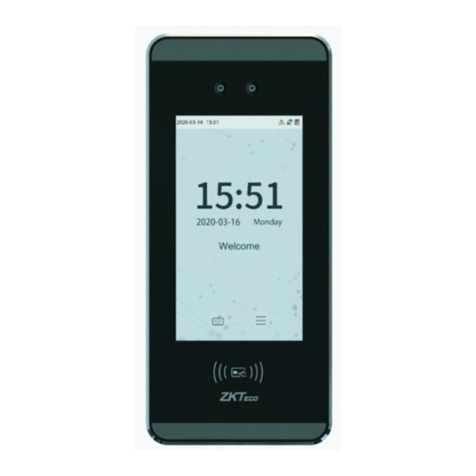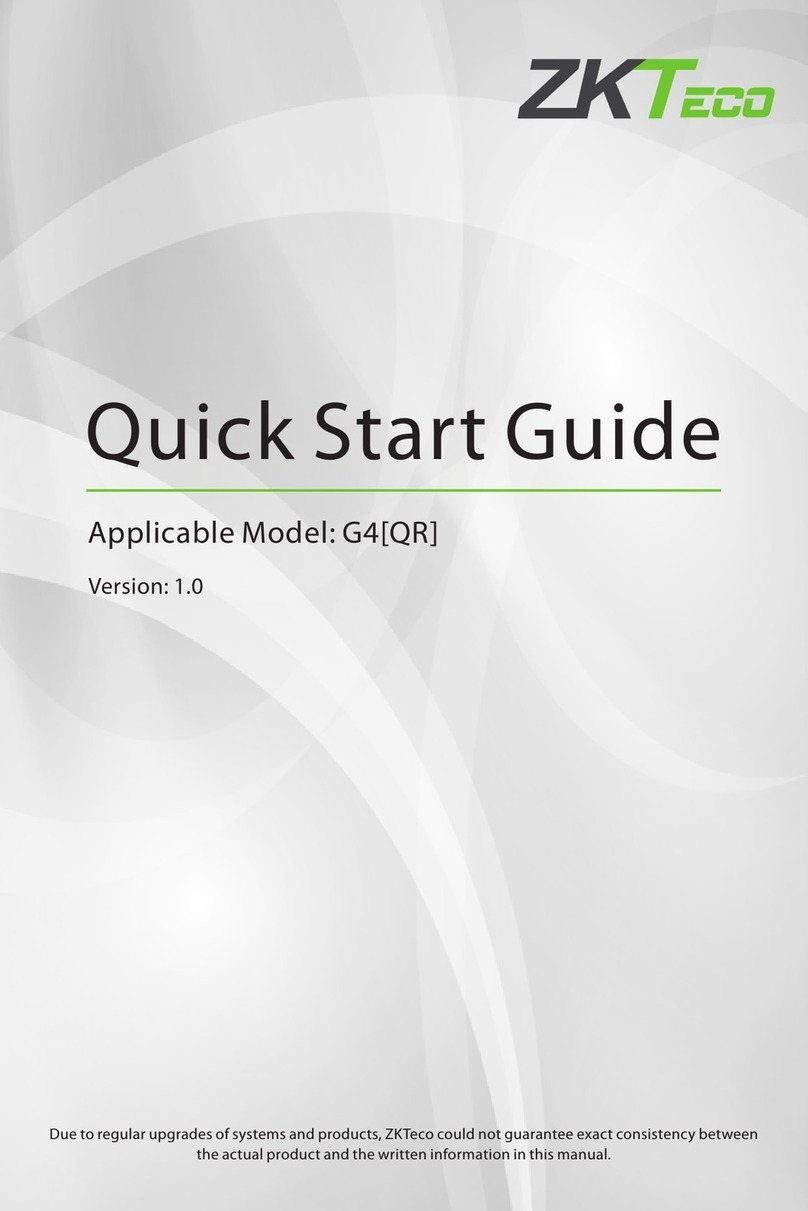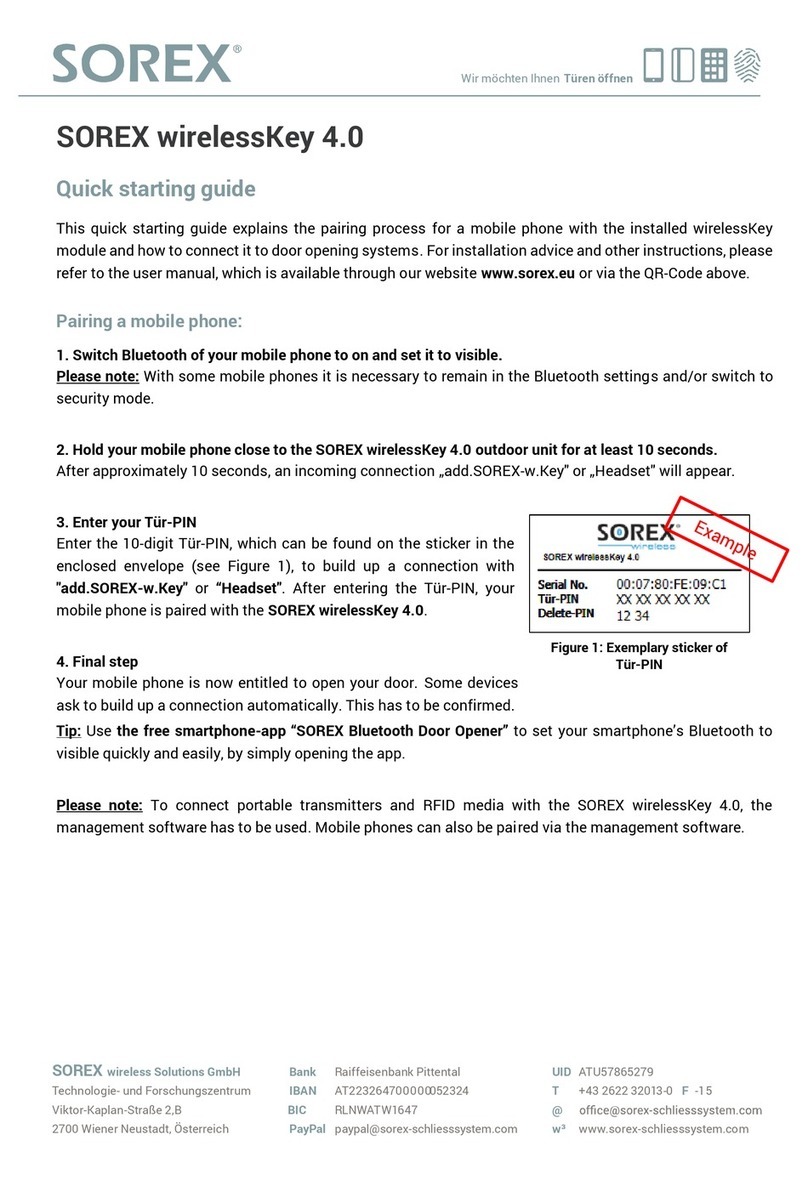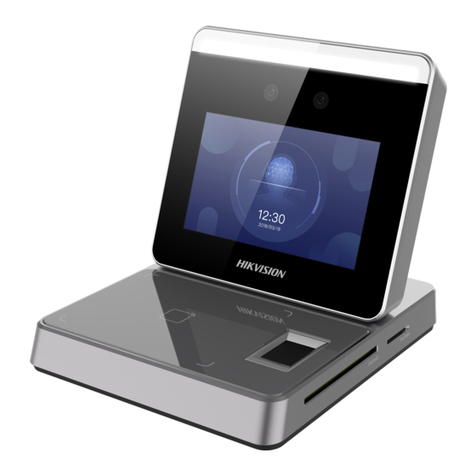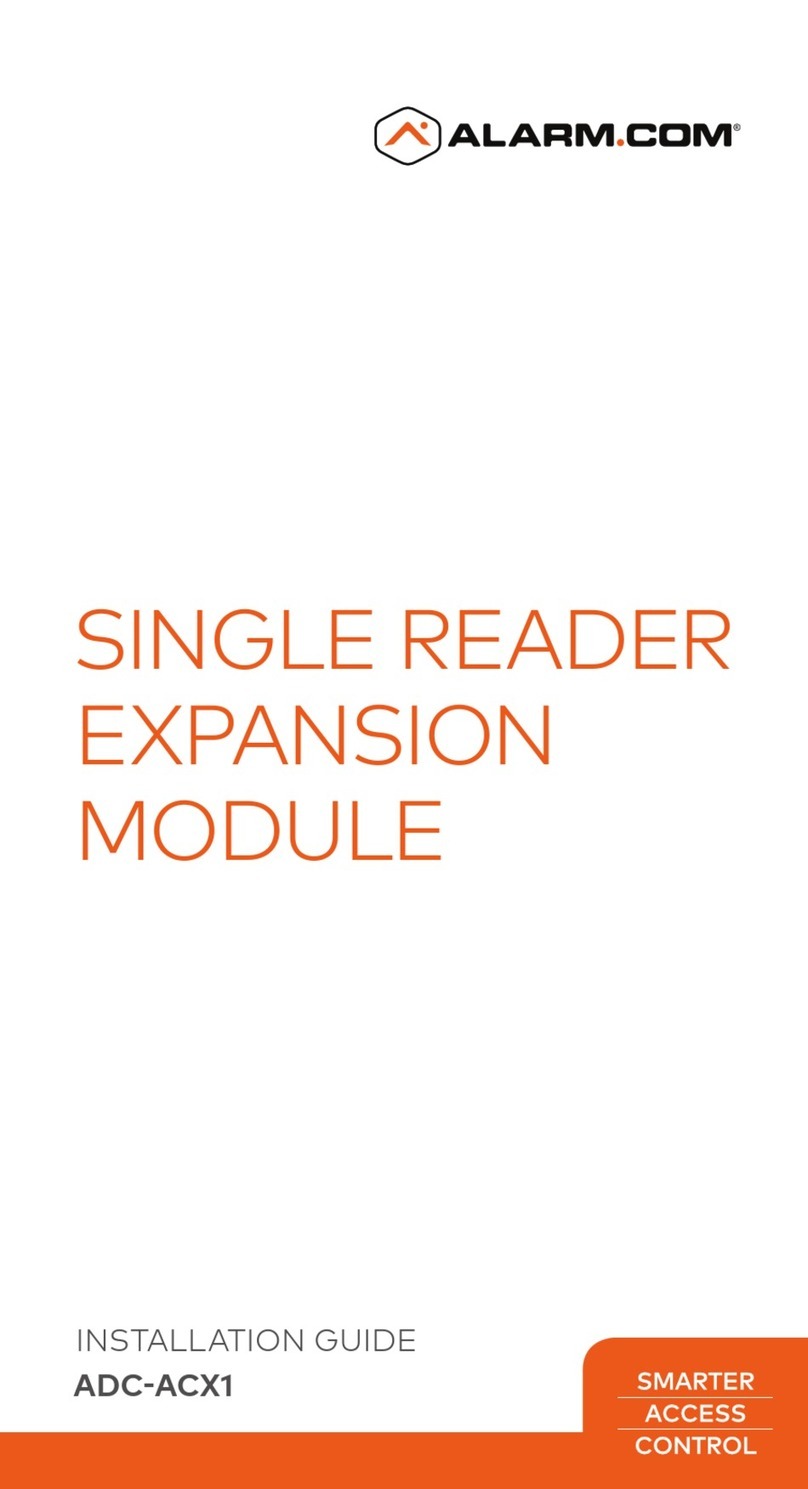Avea WAC2 User manual

WAC2
USER MANUAL
IoT Wiegand Access Controller
29th June, 2018
AVEA International Company Limited
(http://avea.cc)

WAC2 IoT Access Controller
1
Table of Contents
Table of Contents .........................................................................................................................1
WAC2 IoT Access Controller.......................................................................................................3
1. SETUPTHE READER..................................................................................................................4
1.1 DEFAULT SETTINGS ...................................................................................................................4
1.2 RESET CONFIGURATIONS TO DEFAULT........................................................................................4
1.3 FORCE DHCPMODE..................................................................................................................4
2. INSTALLATION............................................................................................................................6
2.1 POWER INPUT AND ETHERNET CONNECTION.............................................................................7
2.2 WIEGAND INTERFACE................................................................................................................9
2.3 RELAY CONTROL.....................................................................................................................10
2.4 DIPSW OPTIONS.....................................................................................................................11
2.4.1 Reset to default...................................................................................................................... 11
2.4.2 Force DHCP enable.............................................................................................................. 11
2.4.3 Test mode...............................................................................................................................12
2.4.4 Reserved DIPSW...................................................................................................................12
2.5 BATTERY .................................................................................................................................12
2.6 RESERVED...............................................................................................................................13
2.7 MECHANICAL DIMENSIONS .....................................................................................................13
3. SOFTWARE .................................................................................................................................14
3.1 REQUESTS TO HTTPSERVER...................................................................................................14
3.1.1 \avea.php...............................................................................................................................14
3.1.2 $date and $time.....................................................................................................................14
3.1.3 $id..........................................................................................................................................14
3.1.4 $uid........................................................................................................................................15
3.1.5 $cmd......................................................................................................................................15
3.1.6 $channel................................................................................................................................15
3.1.7 $mode....................................................................................................................................16
3.1.8 $ver........................................................................................................................................16
3.1.9 $recno....................................................................................................................................16
3.1.10 $rdate and $rtime................................................................................................................16
3.1.11 $sid ......................................................................................................................................16
3.1.12 $deviceid .............................................................................................................................16
3.1.13 $md5....................................................................................................................................17
3.1.14 $event and $cn.....................................................................................................................17

WAC2 IoT Access Controller
2
3.2 RESPONSES FROM HTTPSERVER ............................................................................................18
3.2.1 HB=xxxx................................................................................................................................18
3.2.2 BEEP=x ................................................................................................................................18
3.2.3 CK=YYYY-MM-DD HH:MM:SS...........................................................................................18
3.2.4 GRNT=xx ..............................................................................................................................19
3.2.5 DENY ....................................................................................................................................19
3.2.6 ROOT=xxxxxxxx ...................................................................................................................19
3.2.7 EXT=x...................................................................................................................................19
3.2.8 DHCP=x ...............................................................................................................................20
3.2.9 IP=xxx.xxx.xxx.xxx................................................................................................................20
3.2.10 GW=xxx.xxx.xxx.xxx ...........................................................................................................20
3.2.11 NM=xxx.xxx.xxx.xxx............................................................................................................20
3.2.12 WS=xxx.xxx.xxx.xxx ............................................................................................................21
3.2.13 PT=xxxxx ............................................................................................................................21
3.2.14 RLY=x .................................................................................................................................21
3.2.15 REC_DEL=xxxx..................................................................................................................21
3.2.16 SID=xxxxxxxx......................................................................................................................21
3.2.17 AC=xxxxxxxxxx ...................................................................................................................22
3.2.18 DC=xxxxxxxxxx...................................................................................................................22
3.2.19 APC=xxxxxxxxxx.................................................................................................................22
3.2.20 CLEAR=ALL.......................................................................................................................23
3.2.21 ACPIN=xxxx .......................................................................................................................23
3.2.22 PPC=x.................................................................................................................................23
3.2.23 GRNT2=xx ..........................................................................................................................24
3.2.24 DEN2...................................................................................................................................24
3.2.25 RLY2=x ...............................................................................................................................24
4. PHP CODE EXAMPLE ..............................................................................................................25

WAC2 IoT Access Controller
3
WAC2 IoT Access Controller
WAC2 is an access controller which embedded with Ethernet connection and using HTTP
for communication control protocol. Hence, it can communicate directly with Apache Web
Server or Microsoft Internet Information Server. WAC2 provides 3,000 access cards and
50,000 access logs records.
It is implemented as a HTTP web client. Various page extension is selectable,
like .php, .asp, .cfm, .pl, .htm, .html and .aspx. So various HTTP server systems (e.g. IIS and
ASP from Microsoft; Apache with PHP enabled and mySQL database server from Unix/Linux),
a complete and powerful time attendance system can easily be implemented.
When cards are presented, the transaction information is stored inside the memory of the
reader with 50,000 records allowed. The record is looked up from the local access table with
3,000 records allowed. If access allowed, it will engaged the relay to allow door open. The
memory is retained even power is lost.
The controller provides two Wiegand RFID reader interface and two relays output for
controlling door access.
Whenever there is network connection and the server is running, those records will be
sent to the server. Upon confirmation by the server, the controller will be told to delete the
records accordingly.

WAC2 IoT Access Controller
4
1.Setup the reader
In order to work properly, WAC2 must be configured correctly before putting into actual
usage. For normal condition, the blue LED is blinking.
1.1 Default Settings
The default configurations of the WAC2 is listed as follows:
Parameter
Description
Default
IP
IP address of the reader itself
192.168.1.234
GW
Gateway IP address
192.168.1.1
NM
Netmask
255.255.255.0
WS
HTTP server IP address
192.168.1.1
PT
HTTP server port number
80
EXT
Page extension
php
1.2 Reset configurations to default
If for any reasons, the state of the WAC2 is not known. Before power up, set DIPSW 1 to
on position. When power on, the settings of WAC2 will be cleared and set to the default
settings. DIPSW 1 must be set to off for normal operation.
1.3 Force DHCP mode
When DIPSW 2 is set to on position. DHCP mode will be forced to enable for automatic
configuration of the WAC2.A DHCP server must be available in the network for this
operation. If the DHCP server configured with the options www-server, i.e. option 72, the
web server address of will also be set automatically.

WAC2 IoT Access Controller
5
Example of dhcpd.conf:
#example of dhcpd.conf for AVEA’s IoT devices
ddns-update-style ad-hoc;
subnet 192.168.1.0 netmask 255.255.255.0 {
# --- default gateway
option routers 192.168.1.1; # default gateway
option subnet-mask 255.255.255.0; # netmask
option www-server 192.168.1.123; # it must setup to the web server’s IP
range dynamic-bootp 192.168.1.10 192.168.1.99;
default-lease-time 300;
max-lease-time 3600;
}

WAC2 IoT Access Controller
6
2.Installation
In order to work properly, WAC2 must have stable power supply, a 10-baseT compatible
Ethernet connection. The WAC2 provides interface to connect two Wiegand 26 or
Wiegand 34 RFID reader and each associated with its own relay control.
Remember to remove power when doing any installation or connection.
The following diagram show the PCB of the WAC2 controller.
Remark:
1. Ethernet Connector
2. Channel 1 Relay Connector
3. Channel 2 Relay Connector
4. CR1220 Battery for Real-time Clock
5. Not used
6. DIP Switch Option Sector
7. Wiegand Reader Connector, Channel 1 and Channel 2
8. Reserved

WAC2 IoT Access Controller
7
All connections from the WAC2 is through the RJ45 connector. The following diagram
show the pinouts of the RJ45 plug.
2.1 Power Input and Ethernet Connection
Ethernet connector is a RJ45 terminal which is the connection to Ethernet network and
also the input power to the controller.
The pinouts of the terminals is as follows:
PINOUT
DESCRIPTIONS
1
ETHERNET, TX+
2
ETHERNET, TX-
3
ETHERNET, RX+
4
POWER
5
POWER
6
ETHERNET, Rx-
7
GROUND
8
GROUND

WAC2 IoT Access Controller
8
WAC2 requires 9 to 12V DC 500mAfor normal operation. Since the POWER/GROUND
will be connected to the Wiegand port as well, more current will be needed to drive them.
The power supply must be feed through the POE-02 power injector or equivalent.

WAC2 IoT Access Controller
9
2.2 Wiegand Interface
Wiegand reader connector is a RJ45 terminal for connecting Wiegand 26/34 RFID
reader.
The pinouts of the terminals is as follows:
PINOUT
DESCRIPTIONS
1
POWER
2
CHANNEL 1, DATA0
3
GROUND
4
CHANNEL 1, DATA1
5
POWER
6
CHANNEL 2, DATA0
7
GROUND
8
CHANNEL 2, DATA1
The POWER/GROUNG pair is the power supply to the controller which can be used to
power the Wiegand readers. Be careful of the correct voltage ratings.
DATA0/DATA1 corresponding to the Wiegand’s DATA0 and DATA1.

WAC2 IoT Access Controller
10
2.3 Relay Control
Channel 1 relay connector is a RJ45 terminal which is the channel 1 relay output which
associate with channel 1 wiegand reader.
Channel 2 relay connector is a RJ45 terminal which is the channel 2 relay output which
associate with channel 2 wiegand reader.
The pinouts of the terminals is as follows:
PINOUT
DESCRIPTIONS
1
NC
2
NC
3
CO
4
CO
5
CO
6
CO
7
NO
8
NO
NC - normal close, it is connected to CO normally.
CO - common, it will connects to either NO or NC, but not both.
NO - normal open, it is open circuit normally.

WAC2 IoT Access Controller
11
The maximum switching voltage of the relay is 120VAC or 60VDC, and the maximum
switching current is 2A.But it is recommend to drive low DC voltage only because of the
RJ45 connector’s limitation. Overloading the maximum ratings may cause damages to
the reader permanently and cannot be repaired anymore.
Abypass switch can be added for the manual control of an electric strike or magnetic lock
for door access.
2.4 DIPSW Options
DIP switch option sector is the DIPSW for selecting varies options for the WAC2.
2.4.1 Reset to default
By setting DIPSW position 1 to on, the controller configuration will be reset to the default
state. It must be set to off position for normal operation.
2.4.2 Force DHCP enable
By setting DIPSW position 2 to on, the controller configuration will be forced to enable
DHCP for IP assignment.

WAC2 IoT Access Controller
12
It assumes a DHCP server is available in the local network.
2.4.3 Test mode
By setting DIPSW position 3 to on, the controller configuration will be set to the access
the AVEA’s server for testing purpose. It must be set to off position for normal operation.
It assumes a DHCP server is available in the local network.
Setting DIPSW 1 will clear this settings.
2.4.4 Reserved DIPSW
DIPSW position 4, 5 and 6 is reserved for future use.
2.5 Battery
A CR1220 lithium cell battery is required for the normal operation of the real-time clock. It
is not included in the package. Customer needs to purchase and install by themselves.

WAC2 IoT Access Controller
13
2.6 Reserved
2.7 Mechanical Dimensions
Height: 25mm
Width: 78mm
Depth: 112mm

WAC2 IoT Access Controller
14
3.Software
WAC2 is a HTTP client with PHP enabled. It will send PHP URL requests to the HTTP
server with the various parameters. And it accepts responses from the HTTP server to
perform various actions on the reader.
3.1 Requests to HTTP server
The followings are the variables presented to the PHP. User can access it
correspondingly.
3.1.1 \avea.php
The reader send a GET request to access a fixed web page of the HTTP server:
avea.php located on the root of the website. The file extension is user selectable, e.g.
avea.asp, avea.cfm avea.pl, avea.htm and avea.html. But it is server changeable to any
numeric filename located on the root.
3.1.2 $date and $time
Hold the date and time of that request. The format of date is YYYY/MM/DD, e.g.
2018/06/29 means 29th June 2018. The 24 hour format of time is HH:MM:SS where HH is
hour, MM is minute and SS is second.
3.1.3 $id
It is the IP address of the reader, e.g. 192.168.1.234. It must be set to different value for
each reader in the same subnet in order to function properly.

WAC2 IoT Access Controller
15
3.1.4 $uid
It is the unique code number of the RFID card presented to the reader in hexadecimal
format.
3.1.5 $cmd
It holds the action that was taken on the reader.
I. $cmd=PU, it is sent once after the reader is just power up.
II. $cmd=HB, it is sent when the programmed heartbeat rate is reach. The default
heartbeat rate is 300 seconds.
III. $cmd=PG, it is sent when the reader is being pinged. It can be used to initiate
event from the server side.
IV. $cmd=REC, it is sent with an ID card is read on the reader. The card number is
stored in $uid.
V. $cmd=ET, when changing access card operation is taken. It is sent after the
operation is completed. So the server can decided to take further actions.
3.1.6 $channel
It signify the action is coming from which channel of the WAC2.
I. $channel=1, the action is coming from channel 1
II. $channel=2, the action is coming from channel 2.

WAC2 IoT Access Controller
16
3.1.7 $mode
For WAC2, $mode=AC1. So it can be used to identify the reader.
3.1.8 $ver
It is the firmware revision. Currently it is 1.39.
3.1.9 $recno
Hold the reference number of the record in decimal format. The server must response
this parameter in order to acknowledge the record and confirm the deletion of that record.
3.1.10 $rdate and $rtime
Hold the date and time of the stored record. The format of date is YYYY/MM/DD, e.g.
2018/06/29 means 29th June 2018. The 24 hour format of time is HH:MM:SS where HH is
hour, MM is minute and SS is second.
3.1.11 $sid
This is the value set by the SID response.
3.1.12 $deviceid
This is the unique id of the reader.

WAC2 IoT Access Controller
17
3.1.13 $md5
It is the MD5 checksum of the user's MD5 secret key, date and time. It will be sent together in
the request for identification purpose.
For examples:
assuming
-MD5 secret key is '01234567' (ASCII),
-date of the request is '2012/08/08' (ASCII),
-time of the request is '10:19:54' (ASCII)
the combined string is
-'012345672012/08/08-10:19:54' (ASCII)
hence the MD5 checksum of the combined string is
- b62a8cf4adfdd10874f1121686b0bba9
On the server side, the MD5 secret key is known, so it can compute the MD5 checksum and
check against the received checksum for verification.
Since the MD5 secret key is unknown to others, only those authenticated reader can sent out
correct MD5 checksum.
3.1.14 $event and $cn
They are valid for the $cmd=ET. Whenever add/append/delete card or erase access table is
responded by the web server, the controller finished the operation and will send a request
$cmd=ET to the web server with those parameters.
- $event valid values are { ‘add’ , ’app’ , ’del’ , ’clr’ , ’err’ }
- $cnd is the RFID card number

WAC2 IoT Access Controller
18
3.2 Responses from HTTP server
After sending request, WAC2 will wait for a response from the HTTP server. It looks for
the starting flag <AVEA> and the ending flag </AVEA>. Then it interprets the strings in
between. There must be no space between the keywords and parameters. The
maximum size of the response packet should be less than 600 bytes.
The following responses are supported:
3.2.1 HB=xxxx
Set the heartbeat rate of the reader in seconds. It is a fixed length format in decimal
value. Example:
HB=0300 set the reader send a heartbeat request to the HTTP server once in 300
seconds.
HB=0000 to disable the heartbeat request.
3.2.2 BEEP=x
Make a beep sound on the reader. It is a fixed length format. Example:
BEEP=1 make a short beep.
BEEP=0 make a long beep.
3.2.3 CK=YYYY-MM-DD HH:MM:SS
Set the clock of the reader. The year must be in 2000 to 2099. It is a fixed length format
in decimal values. Example:
CK=2007-01-23 12:34:56 set the clock to 23rd Jan 2007, pm12:34:56.

WAC2 IoT Access Controller
19
3.2.4 GRNT=xx
Set channel 1 of the reader to a grant access state, i.e. to engage the relay from NO
state to NC state for xx seconds and return to NO state. It is a fixed length format in
decimal value. Example:
GRNT=03 set the relay to NC state for three seconds and return to NO state.
3.2.5 DENY
Set channel 1 of the reader to a deny access state, i.e. to make sure the relay is in NO
state.
3.2.6 ROOT=xxxxxxxx
This will change the root page to be access by the reader. It is a fixed length format in
decimal value. For example: ROOT=00024689, this will make the reader to access the
page /24689.php rather than the default /avea.php. By setting ROOT=00000000 will
reset to access the default page.
3.2.7 EXT=x
This will change the root page’s file extension to be access by the reader. It is a fixed
length format.
Value of x
File extension
0
.php
1
.asp
2
.cfm
3
.pl
4
.htm
5
.html
6
.aspx
Table of contents
Other Avea IP Access Controllers manuals

